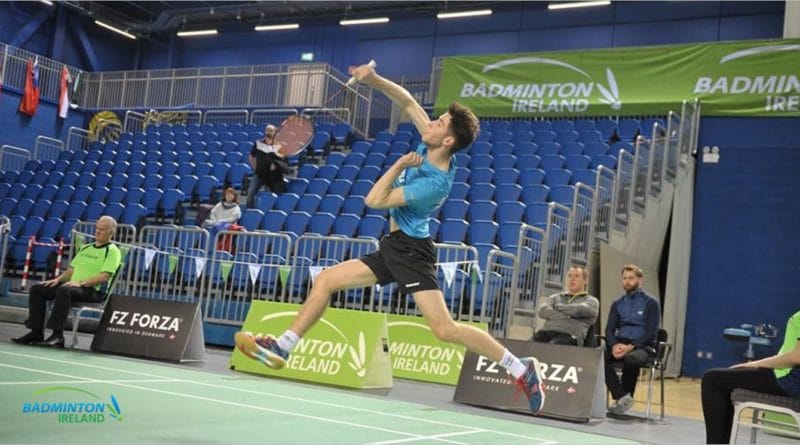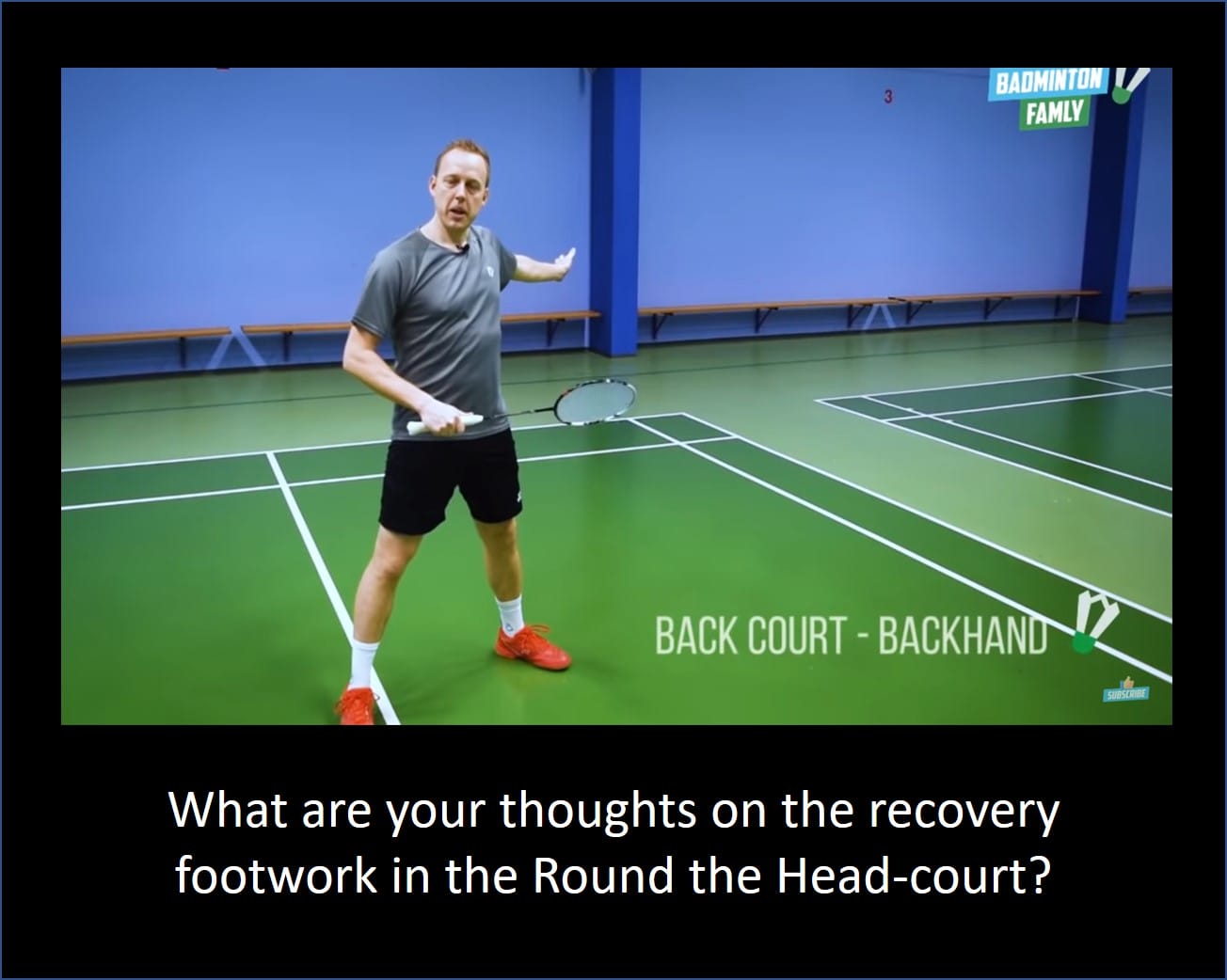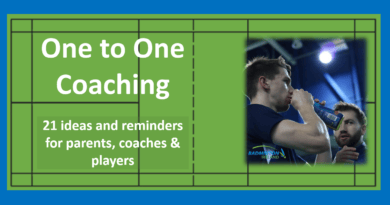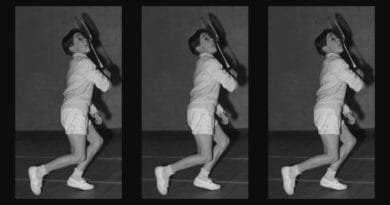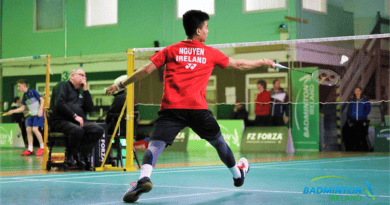6 Ways to improve your Round The Head
What are the secrets to improving your Round the Head?
Would you like to know what coaches are thinking about when helping you with your Round the Head?
Read about
.. how to keep the shuttle inside the court when smashing straight
.. how to move in different ways into this area
.. the key points to help your development
– – – – – – – – – – – – – – – –
1 Rotate in the air
2 Feeding and Practice
3 “Curl”
4 Strokes
5 Wide base on landing
6 Hop to it!
7 (Just for Coaches)
– – – – – – – – – – – – – – – –
1. Rotate in the air
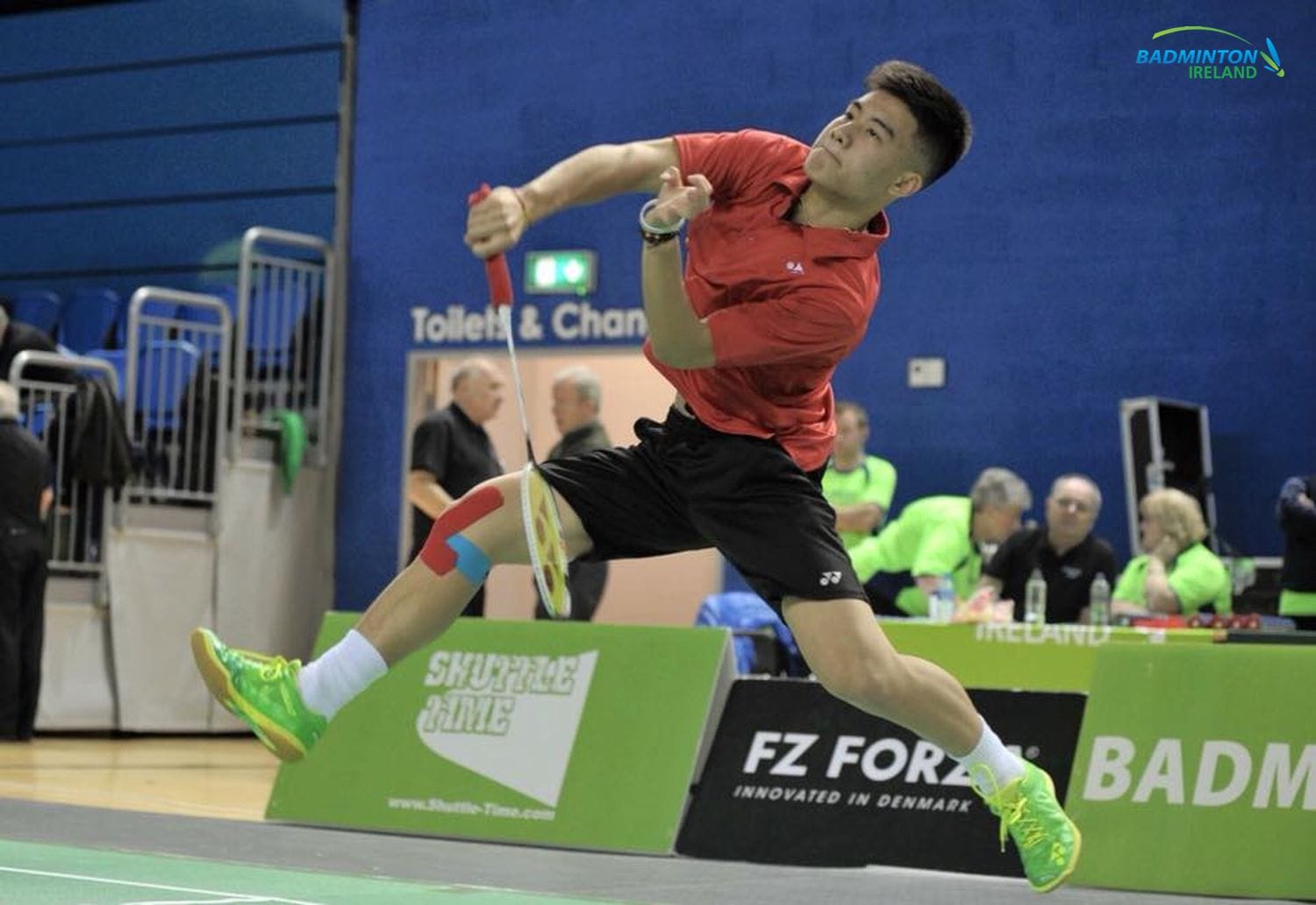 It’s vital that you rotate whilst in the air as part of the movement.
It’s vital that you rotate whilst in the air as part of the movement.
Lift is achieved by a ‘push-up’ off the court with your racket leg (right leg for right-handers). The foot should be turned slightly sideways just prior to ‘lift off’ so that maximum power can be achieved. A common problem often seen with junior players is to try and push up off the toes with the foot pointing forwards and not turned sideways.
Try some shadow work, it’s useful to help players feel the pushing motion and the turning whilst off the ground. Incorporate into warm-up sessions and as part of player ‘homework’. The garden can be a great place to work on these things.
Don’t worry if when a shuttle is introduced the amount of observed rotation reduces.
It can be initially difficult as the player seeks to ‘time’ the jump and turn with the striking of the shuttle. Allow the practice and timing of this power stroke to develop.
– – – – – – – – – – – – – – – –
2. Feeding and Practice
Starting in a forward attacking stance, “as if” to cover an opponent’s likely reply to the backhand net area.
The flick feed should not be too high as for the previous development of overhead work. It needs to encourage the player to move quickly to the shuttle, as if in a match. Progress to crosscourt feeds flicked quickly over the player, with the feeder standing in their backhand court.
Try varying the players starting stance and position. These small changes can make a big impact on the outcome and confidence. A backward attacking stance (receive of serve) will take away the early rotation movement and encourage attention to the push up from the rear leg.
Try this out and see what difference it makes. I recommend that you try both starting stances
Ask the player to start the practice
I recommend that coaches Quickly move to a ‘player start’ type practice. The purpose of the player starts is to illicit game-like responses. The practice starts with the player using either of these two ‘starts’
- blocking (as in defence) from the backhand side. Non-racket foot out to the side
or
- standing in a forward attacking stance and striking a backhand low serve type feed
Both of these ‘starts’ will allow the feeder to flick into the player’s Round The Head. Crucially, the player will start to anticipate a net return before moving into their backhand rearcourt.
Try starting the practice with a block feed. Using both their forehand and backhand, also using straight or crosscourt feeds. This then allows variation for the feeder to either flick upwards or play a net shot. There is a huge benefit to be gained by including ‘feeder’ options (i.e. decisions) combined with player starts.
The decisions made by the player after striking the Round the Head are also important.
If you allow the practice to finish without the stroke being returned then you are missing out. There is much to be experienced/learnt from the result of your own shot whilst you move forward after striking.
Questions
- What would you do after hitting a powerful wide smash that causes the opponent to struggle?
- Which of their possible strokes would you choose to be the most likely?
- Would this cause you to change how you recover?
- What are your thoughts on either running straight forwards in ‘recovery’ anticipating that you will be able to attack them from your net area?
If you feel that this decision making (anticipation) is important then allow for it in your practice
A starting point could be to ask the partner (feeder) to return your Round the Head shot. They could return your shot to either a known place or anywhere they choose. Without some form of decision-making by the player who strikes the RTH down shot, the practice will not deliver the full benefits to that player.
Doing this should also encourage players to realise that they can affect the return of the opponent (the feeder) by slightly varying their own shot: the speed, the slice, the angle, the deception.
Be Aware!
Players and coaches should be aware that this type of work could easily fatigue players so rest periods must be included or the intensity limited. Repetitious landing on the racket leg is also a major factor. However, movements need to be fast, powerful and explosive. Repetitions are required to establish learning and automisation. These factors and those of fatigue/injury need careful management by the coach.
– – – – – – – – – – – – – – – –
3. Curl after striking
 This is the phrase that describes the position of the arms after striking the smash.
This is the phrase that describes the position of the arms after striking the smash.
It is an especially useful coaching cue or image for overhead forehand power strokes. Try it out for yourself by thinking “Curl” as you hit the shuttle hard or with a slice.
On completion of the stroke, both arms will be ‘curled’ across the body.
This action of ‘curling’ has the benefits of aiding accuracy and improving stability in the air and on landing. For those players who continually ‘pull’ the shot out of the side of the court when straight smashing, try asking them to imagine this shape at the end of the stroke.
I love would to hear what happens and if it helps
I have never really explored the bio-mechanical reasons why it is important. All I know is that it works!
Remember that unlike net shots, the non-racket arm does not move behind the player on completion!
– – – – – – – – – – – – – – – –
4. Strokes
It is important that juniors (U9-U14) master straight slow drops and fast ‘hard’ deep clears from this part of the court.
Try these two shot as well and smashes (with and without slice). The slow ‘stop’ drop and deep clear may be more effective in lower age group singles than the smash. These shots place the opponent under pressure and can limit the possible opponent likely replies if played well.
When playing straight slices or smashes it may be best to aim slightly inside the court to limit the effect of the body’s rotation ‘pulling’ the shuttle towards the sidelines. Slicing is a useful method of improving rotation, however, the preparation and recovery positions of the none racket arm is vital as previously mentioned. If smashes and slices constantly drift out of the side of the court the use of the none racket arm should be observed, i.e. “curl”.
Try varying your feeding and don’t forget to include what may be considered tough feeds with lots of decsions to be made. not just high numbers.
Tough feeds are shuttles hit quickly up and over the player. They will encourage early preparation and most importantly encourage the use of ‘stop’ drops and fast flat clears. However, this practice only works if the feeder tries to return the shuttle and act like an opponent.
Be Aware
Static feeding can produce what appears to be a consistent stroke, howver it is the ability to cope with a variety of feeds /indecision AND to then understand the effect the stroke it has on the opponents’ likely reply.
That should be the goal of the practice.
Remember to include
- Varying levels of decision making in the practice
- Decision making from the feeder and by the player practising the round the head strokes
- Allow for both players to act as if they were in a competition
- To achieve this you will probably need the player hitting the Round the Head to start the practice

– – – – – – – – – – – – – – – –
5. Wide base on landing
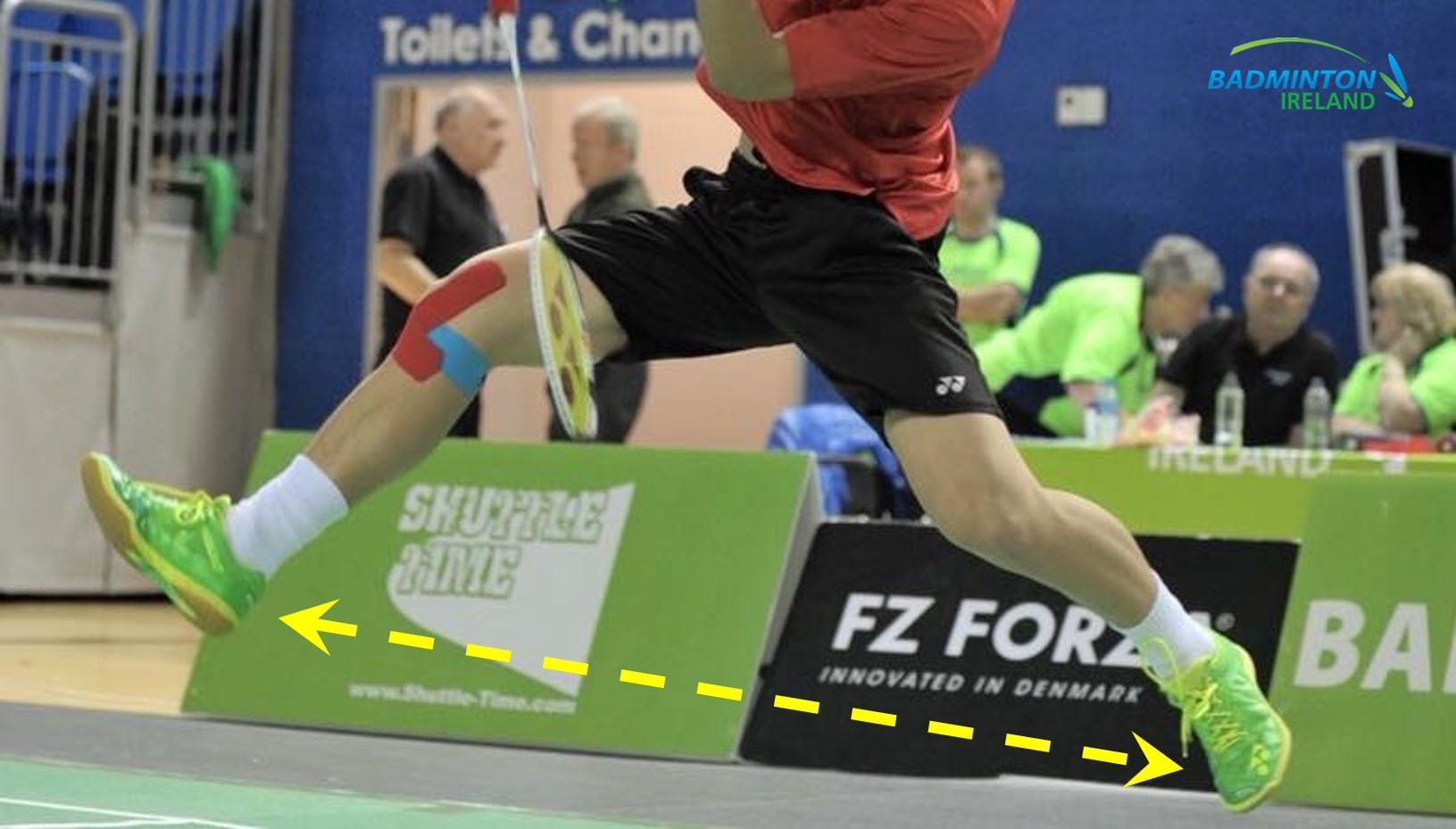 Landing and recovery are important.
Landing and recovery are important.
Players should try to land with wide legs and with the body weight between your legs, i.e. not falling backwards.
The rear foot is often turned sideways but some elite players may land on the front of the foot with the heel pointing backwards. Whilst this position is very efficient for fast forward movement it places a strain on the ankle, foot and achilles tendon.
Coaches should emphasise “land wide”! This may encourage a more powerful pushing up and hitting action and will also assist with the forward recovery / early preparation movement.
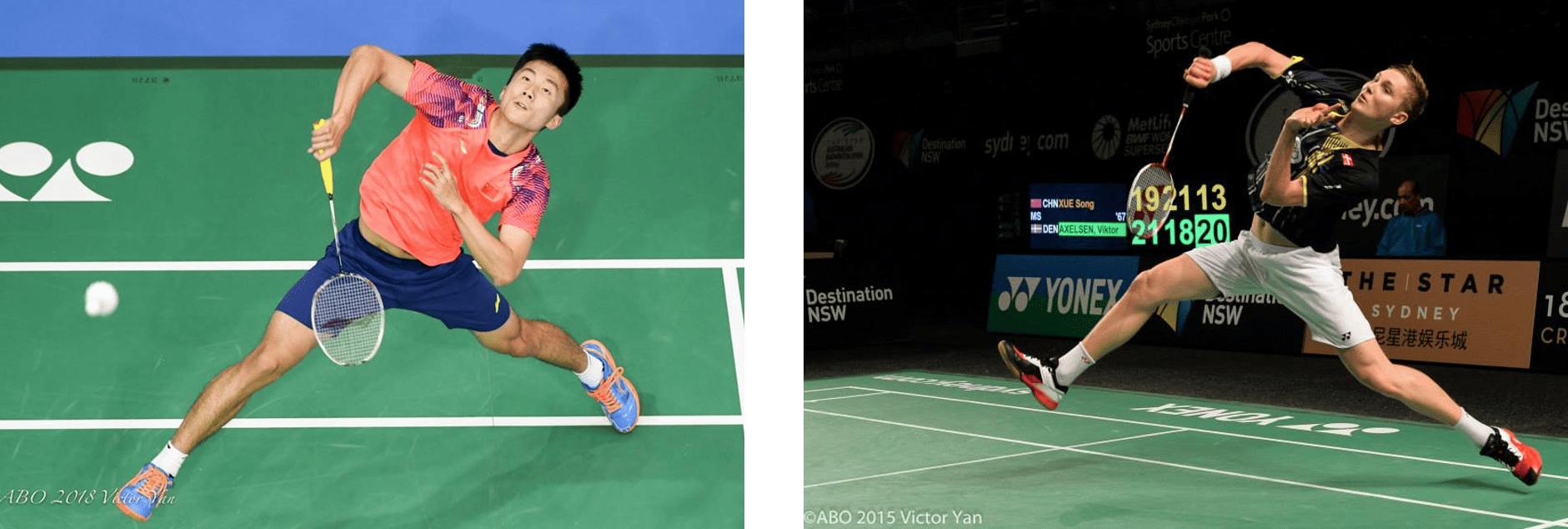
– – – – – – – – – – – – – – – –
6. “Hop to it” or “turn & chasse”
There are two different types of movement into the Round the Head court and both are used by elite players.
Developing players should initially be shown both and encouraged to try both. As the players develop physically; power, body shape, speed, etc. the preferred movement choice may change.
The two movements are either a ‘step-hop-turn-jump’ movement or a ‘turn-chasse-jump’ movement
Hop – turn – jump
The hop and turn’ movement has the first step with the non-racket foot. This is desirable to achieve the maximum distance during the initial movement phase of the technique. No matter what starting stance (forward attacking or square defensive), the non-racket leg will initially move backwards and then hop whilst the body rotates, as the racket foot lands the player then pushes off the ground jumping and rotating again in the air.
This ‘hopping’ element may not always be apparent with junior players if they do not possess the leg strength or the muscular control to turn and hop at the same time. They may be seen to fall backwards during the movement and should be encouraged to perform a smaller hop but also to try and get their racket leg ‘behind’ them prior to pushing up off the ground. The more dynamic and explosive the player the more the speed and distance covered during the hop and turn phase.
Turn-chasse-jump
The ‘turn-chasse-jump’ movement may be easier to initially coach and execute. The player turns from either a defensive or forward attacking stance into a backward (receive of serve) stance. Then chasses backwards finally jumping and rotating.
What do you think?
Both movements will be seen if you watch videos of elite players. Please try them and let me know which you prefer and which you find more effective. Drop a comment at the bottom and share your thoughts and observations
– – – – – – – – – – – – – – – –
Just for Coaches
7 “look past …”
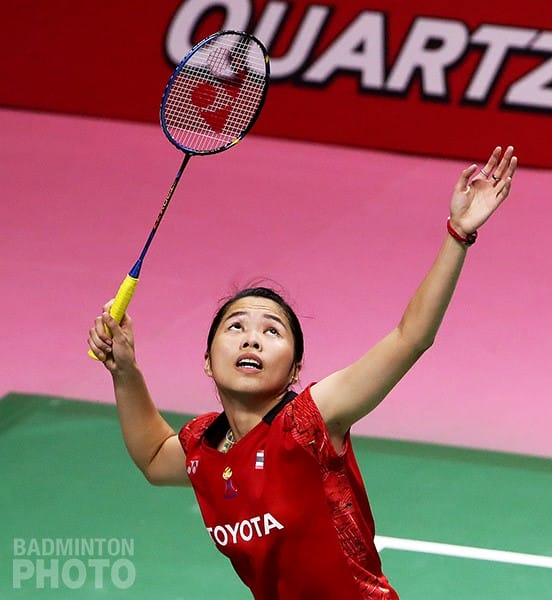 The starting position of the non-racket hand is important in the preparation because it ensures that the following movements have the best chance of producing a positive result.
The starting position of the non-racket hand is important in the preparation because it ensures that the following movements have the best chance of producing a positive result.
Your non-racket hand (the one that inst holding the racket) should be somewhere in front of you around eye level.
I encourage players to have a preparation similar to that in this picture. You may find that the arm is sometimes slightly bent and the hand pointing more towards the racket head.
Requiring players to all have exactly the same overhead preparations is not the goal. Aim for having the non-racket arm in front and the hand above or at eye level. The exact position will vary from player to player and change as they mature and improve.
I like to encourage young developing players to have the non-racket arm positioned so that the player can see past the back of the arm (hand) to observe the opponent.
Here are two effective coaching cues that hopefully will work with some of your players and ensure that they move into this position:
… Ask the player to imagine that they can see the back of their non racket arm in preparation
… Ask the player to imagine that they can see the opponent by “looking past their non-racket arm”
It is not important that they can actually see both of these suggestions
- It is more about the outcome for you as a coach
- Both will turn the shoulders sideways
- There is no need to explain the result to the player, merely try one of the cues above. Then see what happens.

